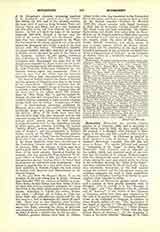

Boccaccino, BOCCACCIO, an eminent Italian painter, b. at Cremona, 1460, and d. probably in 1525 rather than in 1518, the date usually given. He studied, it is thought, with followers of Mantegna, at Ferrara, and was a pupil or fellow-student of Domenico Panetti. At Cremona he painted in Sant’ Agostino a series of frescoes. He had as an assistant Benvenuto Garofalo, who left him and went to Rome. The master followed and painted a “Coronation of the Virgin” in Santa Maria in Trastevere. This, however, was so ridiculed by the public, which had expected much of one who had had the hardihood to criticize Michael Angelo, that the disappointed artist returned to Cremona where, among his most appreciated works, is a frieze in the cathedral, showing the “Birth of the Virgin” and other subjects from the life of Our Lady. Lanzi, who considered Boccaccino as the best modern among the ancients and the best ancient among the moderns, compares his work in these productions with that of Perugino, treating it as inferior in some qualities while superior in others.
The works of Boccaccino possess much charm, and a number of them greatly resemble those of Perugino. This is notably so in his “Marriage of the Virgin” and “The Madonna with St. Vincent and St. Anthony” in the church of San Vincenzo ac Cremona, which have often been assumed to be the work of the greater painter. Among Boccaccino’s works in the cathedral at Cremona, in addition to those already spoken of, are: “The Appearance of the Angel to Joachim“; “The Meeting of Joachim and Anna“; “The Circumcision“; “Christ Reasoning with the Doctors”; and “Christ with the four Patron Saints of Cremona”. At the Academy in Venice is his much admired “Marriage of St. Catherine” and “Virgin and Child in a Landscape”, and in the church of San Giuliano, in the same city, is his “Virgin and Child with four Saints”. The Louvre possesses a “Holy Family“; the London National Gallery a “Procession to Calvary”, formerly in a Cremona church; and the Ferrara Pinacoteca a “Death of the Virgin”. Light grey eyes outlined with a dark rim are characteristic of the pictures of Boccaccino.
BOCCACCINO, CAMILLO, a short-lived but brilliant painter, b. at Cremona, 1511; d. 1546. He was the son and pupil of Boccaccio Boccaccino, whom he surpassed, taking care, it is pointed out, to avoid the errors into which his father’s self-esteem had led him. He early showed both originality and strength, and his work has been considered to approach that of Correggio, notably his “Four Evangelists” in the niches of the cupola of San Sigismondo near Cremona, which are thoroughly in the Correggio style and were painted when the artist was only twenty-six. Camillo Boccaccino is thought by Lanzi to be the greatest artist of the Cremonese school. Two of his works at Cremona are “The Raising of Lazarus” and the “Adulteress before Christ”, surrounded by friezes showing many angels.
AUGUSTUS VAN CLEEF

